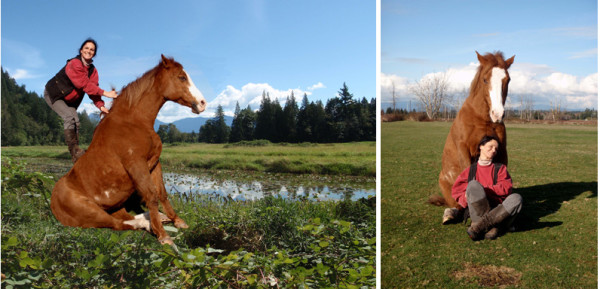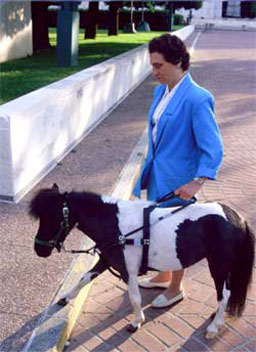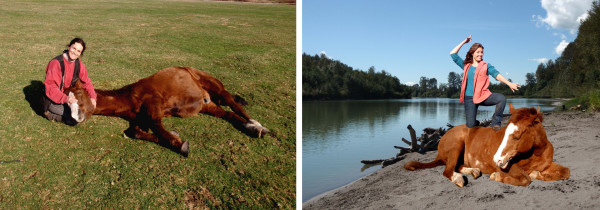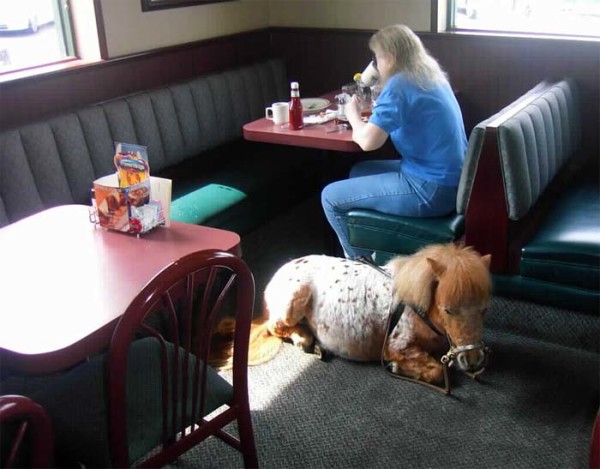Your horse’s IQ – Part 16
|
|
Der IQ Ihres Pferdes – Teil 16
|
- After learning a lot about obstacle avoidance in the last Blog, we now get to Point 10 on our learning list of voice commands for a guide animal.
10) The commands “Down!” and “Sit!”
- For these two commands we can’t go to the books for guide dogs for instruction, as obviously here the training of dogs and horses is very different.
- Our horses do both, lying down as well as sitting, on command, but we train this for gymnastic purposes rather than to make them wait patiently, as is necessary for a guide animal.
|
|
- Nachdem wir im letzten Blog viel über das Vermeiden von Hindernissen gelernt haben, kommen wir nun zu Punkt 10 unserer Lern-Liste für Führtiere.
10) Kommandos „Platz!“ und „Sitz!“
- Bei diesen beiden Befehlen können wir uns nicht an den Büchern über Blindenhunde ausrichten, da der Bewegungsablauf bei Hunden und Pferden sehr unterschiedlich ist.
- Unsere Pferde können beides, sie legen sich auf Kommando ab und sitzen, aber wir üben das aus gymnastischen Gründen und nicht um sie geduldig warten zu lassen, wie das bei Führtieren üblich ist.
|
|
|
- In my book “From Leading to Liberty” I describe on page 287, Game 74 “Lying Down”, and Game 75 “The Sit” on page 292, with many clear illustrations, how it is done according to our training guidelines. See also under my website button DVDs by Eva Wiemers the free video to show you the training in detail.
|
|
- In meinem Buch “From Leading to Liberty” beschreibe ich mit vielen klaren Illustrationen auf Seite 287 im Spiel 74 das “Ablegen” und im Spiel 75 (Seite 292) das „Sitzen“, genau wie wir es nach unseren Trainingsrichtlinien lehren. Unter der Rubrik „DVDs by Eva Wiemers“, hier auf der Webseite, können Sie in den Videos kostenlos das Training im Detail anschauen.
|
|

|
- Guide horses don’t have to sit at all. The training lying down on command is however important, as this applies in situations like longer waits in restaurants for example.
- With a miniature size pony one might choose a different teaching approach from ours for the lie-down, as shown here in a quote from Alexandra Kurland, a clicker trainer:
- “I shaped her to drop her head, and to yield her front knee into my hand. I could draw her knee back so she was starting to kneel. Click and jackpot: a tiny bit of carrot. Once that was consistent, I let the clicker take over. At first she wasn’t sure what to do next. This was not the way horses naturally lie down, but as I let her sort out the possibilities, she quite abruptly folded her legs underneath her and dropped to the ground. She didn’t stay down more than a second, but that was long enough for me to click and reinforce her.”
- The problem with such anecdotes is that it doesn’t help you to proceed, if this approach DOESN’T work for your mini. Most people try to bribe and lure their horses down with food, which never leads to a consistent and dependable performance. (And you remember that guide horse trainers also do NOT use food for training!)
|
|
- Führminis müssen gar nicht sitzen. Das Ablegen ist aber wichtig, da sie sich in vielen Situationen des längeren Wartens, z.B. im Restaurant, hinlegen sollen.
- Mit einem Pony von Miniaturgröße kann man ein von unserer Lehre unterschiedliches Verfahren zum Ablegen wählen, wie hier in einem Zitat von Alexandra Kurland, einer Klickertrainerin:
- „Ich formte das Absenken ihres Kopfes und ein Nachgeben ihres vorderen Knies in meine Hand. Dann zog ich ihr Bein zurück, so daß sie anfing zu knien. Klick und Jackpot: ein kleines Stück Möhre. Als das konstant klappte, stellte ich auf den Klicker um. Zuerst war sie sich nicht sicher, was sie machen sollte. Das war ja nicht die Weise, wie sich Pferde natürlich ablegen, aber als ich ihr Zeit gab ihre Möglichkeiten auszuprobieren, klappte sie abrupt ihre Beine unter sich zusammen und ging zu Boden. Sie blieb zwar nur eine Sekunde unten, aber das war für mich lang genug zu klicken und sie zu bestärken.“
- Das Problem mit solchen Anekdoten ist, daß sie Ihnen beim Training nicht weiterhelfen, wenn so ein Vorgehen bei Ihrem Mini NICHT zündet. Die meisten Leute versuchen ihre Pferde zu bestechen und mit Futter zu Boden zu locken, was nie zu einer konstanten und verläßlichen Leistung führt. (Dazu kommt, daß Führtier-Ausbilder NICHT mit Futter trainieren!)
|
|
|
- For any horse it is enormously important that it feels SAFE lying down rather than forced, thrown or tied. It needs peace of mind to do the exercise willingly – and this is why we teach it to our full-grown horses with the balancing help of the foot-lunge. Our horses know at any given moment that they are supported by us and can’t fall, until they have figured out the way to balance and land softly by themselves.
- Blind or not – this is a great exercise if trained correctly and keeps your lives interesting!
- The next two commands are needed when a blind person manoeuvres around swinging doors.
11) “Come!”
- is the command used in situations where a door swings from the right. The guide mini or dog would then go to the handler’s right side while the door is being opened, then circle around his back to return to the master position, maintaining constant body contact with the person, so the blind can feel where the animal is at any given point.
12) “Around!”
- is used when the door swings from the left: here the dog or mini is brought from the master position to the right side of the handler and in front of him, and after passing the doorway it will move back into the master position behind the handler.
- This is important for the blind person and interesting to know, but does not inspire me to try out particular training games with Beau, so I will leave it here.
The next command is:
13) Leave!
- This command is also not very interesting to me, as I cover all situations, where you might need it, with my “Nein!” command. “Nein” means “don’t do what you are doing or just planning to do”, pronounced in an un-emotional tone and very consistently enforced. I understand the Leave command is mostly used for guide animals, when they become interested in available food – a great and unfortunately forbidden temptation of course, especially when waiting in restaurants.
14) “Find…!”
- This is very interesting! However, all the Helping Hooves Book (page 67) gives me is the following: “Guide Horse Training involves the following areas: … “Finding” and indicating targets, such as door handles, curbs, steps, elevators, escalators, tables, seats and the minivan.” and on page 43:
- While training Twinkie (one of the minis) it says “She even succeeded in learning to find the button to call for the elevator when verbally cued to, “find the button” … Yes, but HOW? That is all the information we get, which is not very helpful!
“Find curb!”
- I suppose the first “find” command would be the curb, as it is so essential for walking anywhere and crossing streets. I can imagine that the guide animal would tend to slow down, because the surface changes. The blind person then feels with her right foot past the animal’s nose (corrects with the lead if necessary) and asks for a full stop. The command “find curb!”is then repeated and the animal praised. Over time the mini would associate this routine with the verbal command “find curb!” (And must perform the same on the other side of the street to step up again).
|
|
- Für jegliches Pferd ist es sehr wichtig, daß es sich SICHER fühlt, wenn es sich ablegt, anstatt gezwungen, geworfen oder gefesselt. Es braucht Seelenruhe, um die Übung willig auszuführen – daher bringen wir es unseren großen Pferden mit der Balance-Hilfe der Fußlonge bei. Unsere Pferde wissen, daß sie jederzeit von uns gehalten werden und nicht umfallen können, bis sie selbst heraushaben, wie man balanciert und sanft zu Boden geht.
- Blind oder nicht – das ist eine tolle Übung wenn man es richtig macht und hält unser Leben interessant!
- Die nächsten Befehle werden gebraucht, wenn ein Blinder um schwingende Türen herum manövrieren muß. (die Namen der Befehle mögen auf deutsch anders lauten)
11) „Komm!“
- ist das Kommando in Situationen, wo die Tür von rechts schwingt. Das Führmini oder der Hund wird dann an dessen rechte Seite gehen, während die Tür geöffnet wird, danach hinter seinem Rücken herum wieder vor in die Masterposition gehen, und während der ganzen Prozedur einen engen Körperkontakt mit seinem Menschen halten, damit der jederzeit fühlen kann, wo sein Führer ist.
12) „Herum!“
- wird verwendet, wenn die Tür von links schwingt: hier geht der Hund oder das Mini aus der Masterposition vor dem Menschen auf dessen rechte Seite und nach dem Durchschreiten der Türöffnung geht es hinter dem Blinden in die Masterposition zurück.
- Das ist für den Blinden wichtig und interessant zu wissen, aber es inspiriert mich nicht, es mit Beau in besonderen Trainingsspielen auszuprobieren, so daß ich es hierbei belasse.
Das nächste Kommando ist:
13) “Laß es!” (oder “Aus!”)
- Auch dieses Kommando ist für mich nicht so interessant, da ich schon alle zutreffenden Situationen mit meinem „Nein!“ Kommando abdecke. „Nein!“ bedeutet “tu nicht das, was du gerade tust oder zu tun vorhast” – un-emotional ausgesprochen und sehr konsequent geltend gemacht. Soweit ich verstehe wird das „Laß es!“ Kommando bei Führtieren hauptsächlich benutzt, wenn sie an vorhandenem Futter interessiert sind – eine große und leider verbotene Versuchung, vor allem, wenn sie in Restaurants warten müssen.
14) „Such… !“
- Das ist sehr interessant! Aber das „Helping Hooves“ Buch (Seite 67) verrät mir nur das Folgende: „Führpferdetraining beinhaltet die folgenden Bereiche…. „Auffinden“ und Zielobjekte anzeigen, wie z. B. Türklinken, Bordsteine, Stufen, Treppen, Aufzüge, Rolltreppen, Tische, Sitzplätze, und das Auto.“ und auf Seite 43: Während sie das Pony Twinkie ausbilden: „Sie lernte sogar den Knopf zum Lift rufen auf Stimmkommando zu finden…“. Ja, aber WIE? Mehr Information bekommen wir nicht – nicht sehr hilfreich!
“Such Bordstein!”
- Ich denke mal, das erste „Such!“ Kommando würde der Bordstein sein, da es so wesentlich ist, wenn man Straßen überquert. Vermutlich wird das Führtier schon von allein langsamer, da sich ja die Oberflächer verändert. Der Blinde fühlt dann mit seinem rechten Fuß vor der Nase des Führers (und korrigiert mit der Leine, falls nötig) und verlangt ein Anhalten. Das Kommando „Such Bordstein!“ wird wiederholt und das Tier wird gelobt. Mit der Zeit assoziiert das Mini diese Routine mit dem Wortkommando „Such Bordstein!“ (und muß alles auf der anderen Straßenseite ja nochmal machen, um wieder auf den Gehweg zu kommen).
|
 “Find curb!” “Such Bordstein!” |
- Finding a set of stairs or the elevator in a big shopping mall, or even the car in a huge parking lot is however a different challenge! A dog might perform part of this task with his sense of smell (at least in the case of his own car), but a mini must do it by sight and memory.
- I don’t want to speculate on something I do not know. I am very frustrated that none of the literature really tells me how to do it. My horses have learned to go to targets when I point, and you can find how in the book “From Leading to Liberty” Games 52 and 53 on page 211 ff. So with finger pointing to a target and constant repetition of the applicable word command – and consistent reinforcement – the animal might eventually associate both.
- Experience is surely the key, and the book on training dogs is more explicit. They give examples: “Find door!” is first introduced by the trainer on the leash and eventually leads to the dog slowing a bit at any door to look at the handler (‘do you want to go in ?’) and then reinforced only when the command was given. When teaching “find the knob!” you touch dog’s muzzle and then the knob – this way he learns by following the hand. In a coffee shop, to teach “find a chair” initially use the lead to make the association. The same goes for “find the counter!” to pay, “find the door” to leave, (ascertaining the swing direction “around!”, then “forward!” etc.)
- I have read that dogs learn up to 23 different “find” commands, from finding the owner’s keys or purse to finding the post office.
- And if it is true that a mini can learn all this (PLUS the following commands still to come in the next Blog!) in the training time of less than a year, I am truly amazed!
Read on !!!
|
|
- Aber eine Treppe oder den Aufzug in einem großen Einkaufszentrum zu finden oder das Auto auf einem großen Parkplatz, ist ja nochmal eine ganz andere Herausforderung! Ein Hund kann das Problem vielleicht zum Teil mit seiner Nase lösen (zumindest, wenn es sich um sein eignes Auto handelt), aber ein Mini muß es auf Sicht und mit dem Gedächtnis schaffen.
- Ich will nicht über etwas spekulieren, was ich nicht weiß. Ich bin frustriert, weil ich nichts in der Literatur finde, das mir wirklich sagt, wie man es macht. Meine Pferde haben gelertn, auf Zeigen zu Zielobjekten zu gehen, und im Buch “From Leading to Liberty” Spiel 52 und 53 auf Seite 211 ff sehen Sie wie. Mit Fingerzeigen auf ein Zielobjekt und ständiger Wiederholung des passenden Wortkommandos – und konsequentem Verstärken – wird das Tier vermutlich auf Dauer beides assoziieren.
- Erfahrung ist sicher der Schlüssel und das Hundebuch ist deutlicher. Sie geben Beispiele: „Such die Tür!“ wird vom Trainer erst an der Leine gelehrt und führt schließlich dazu, daß das Führtier an jeder Tür ein bißchen langsamer wird und den Ausbilder anschaut (willst du hier rein?‘) und wird dann nur bestärkt, wenn zuvor das Kommando gegeben wurde. Wenn sie das „Such die Klinke!“ lehren, berühren sie erst die Nase des Hundes und dann die Klinke – so lernt der Hund es, da er der Hand folgt. Auch beim “Such Sitzplatz!” finden im Café wird anfangs die Leine benutz, um die Assoziation herzustellen. So lernt das Tier auch „Such die Kasse!“ (zum Bezahlen), „Such die Tür!“ zum Verlassen des Cafés (nach Feststellen der Öffnungsrichtung) usw.
- Ich habe gelesen, daß Bliindenhunde bis zu 23 verschiedene „Such!“ Kommandos lernen, vom Auffinden des Schlüssels oder Handtasche, bis zum Finden des Postamts.
- Und wenn es stimmt, daß die Minis auch all das lernen können (PLUS der Kommandos, die ja im nächsten Blog noch kommen!), und all das in einer Lehrzeit von weniger als einem Jahr, dann bin ich wirklich verblüfft!
Lesen Sie weiter !!!
|
|
|
|
|





